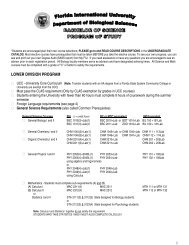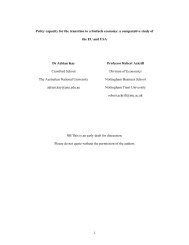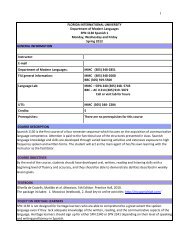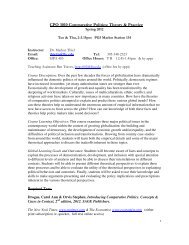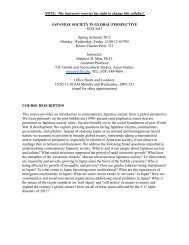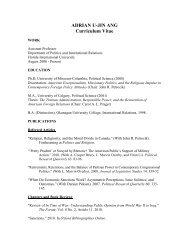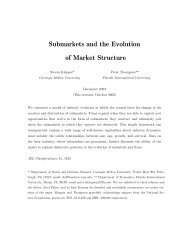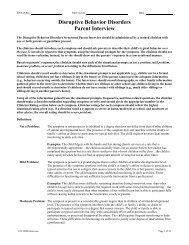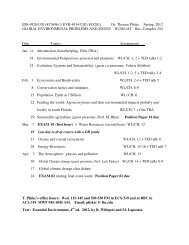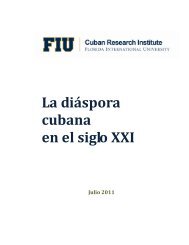Women's Studies - College of Arts & Sciences - Florida International ...
Women's Studies - College of Arts & Sciences - Florida International ...
Women's Studies - College of Arts & Sciences - Florida International ...
You also want an ePaper? Increase the reach of your titles
YUMPU automatically turns print PDFs into web optimized ePapers that Google loves.
At the opening <strong>of</strong> the “Women’s Work / Men’s Work: Labor and Gender in America” exhibit. Left to right: Dr. Alex Lichtenstein<br />
(History), Women’s <strong>Studies</strong> interns Mirtha Soto and Stephanie Acevedo, Dr. Laurie Shrage, and Dr. Jon Mogul (FIU Wolfsonian).<br />
“Women’s Work / Men’s Work:<br />
Labor and Gender in America” is<br />
the inaugural exhibit <strong>of</strong> the Wolfsonian<br />
Teaching Gallery at the Frost Museum.<br />
The exhibit displayed <strong>of</strong> the<br />
divide in the American workforce due<br />
to gender, and how this division was<br />
presented through public art, advertisements<br />
and announcements. The<br />
collection was curated by Drs. Jon<br />
Mogul and Alex Lichtenstein who<br />
were assisted by two <strong>of</strong> our Women’s<br />
<strong>Studies</strong> interns, Mirtha Soto and<br />
Stephanie Acevedo. Below is a partial<br />
interview <strong>of</strong> their experiences<br />
working with the Wolfsonian. (Please<br />
see the full article in Making Waves,<br />
Vol. 9 by Associate Editor, Maria<br />
Murriel.)<br />
After working with the exhibit,<br />
what are your thoughts about “male<br />
work” vs. “female work?”<br />
Stephanie: In this exhibit it is clear<br />
that male work is typically seen as<br />
something that requires skill while<br />
female laborers are <strong>of</strong>ten marginal‐<br />
ized, labeled "temporary workers,"<br />
who are just filling in for their male<br />
counterparts who are away at war.<br />
Not only are the women laborers<br />
seen as transient but the skills they<br />
do have, like sewing, are attributed<br />
to their gender rather than some‐<br />
thing that must be learned. It is<br />
seen as something that is innate in<br />
women, something they were born<br />
to do since they (supposedly) have<br />
tiny hands.<br />
Was there any one thing in particu‐<br />
lar that now strikes you as amazing,<br />
incredible, etc.?<br />
Mirtha: I just find it wonderful and<br />
sometimes surprising how telling<br />
the kinds <strong>of</strong> the objects at the Wolf‐<br />
sonian can be when studying the<br />
society that produced them. I par‐<br />
ticularly love how something as<br />
seemingly inane as soap advertise‐<br />
ment cards can suddenly say so<br />
much about women's labor when<br />
viewed from a different perspective.<br />
Could you tell us a little bit about<br />
“gendered perspectives”?<br />
Stephanie: Gendered perspectives<br />
assign roles to men and women in<br />
society. While this exhibit focused<br />
on labor, gendered perspective im‐<br />
pacts every aspect <strong>of</strong> our lives,<br />
downright to the opportunities that<br />
we come across and the way we in‐<br />
teract with each other.<br />
How would you describe your in‐<br />
ternship with the <strong>Women's</strong> <strong>Studies</strong><br />
Center?<br />
Mirtha: I truly enjoyed internship<br />
because I was able to contribute<br />
concretely to a project, and at the<br />
same time I was allowed to explore<br />
my own capabilities. That is, I felt<br />
that there was a balance between<br />
the work that needed to be done,<br />
and my choice in selecting which<br />
tasks I would gain the most from<br />
performing.<br />
Women’s <strong>Studies</strong> Center Annual Report, 2009-2010 33




